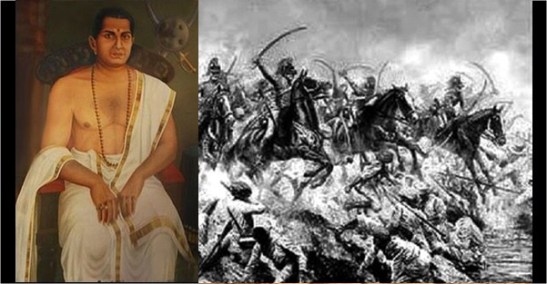How Pazhassi Raja of Kerala Resisted Troops of Hyder Ali, Tipu Sultan, and British

Pazhassi Raja! He was a brave warrior known to many from Kerala but almost unknown to the rest of India. At a young age of 21 he became the prince regent of the princely state of Kottayam of Malabar. He ruled as king from 1774 to 1805. He bravely resisted Hyder Ali’s troops using guerrilla warfare techniques. In later years, he also resisted Tipu Sultan’s troops. He was one of the earliest freedom fighters of India. Even Arthur Wellesley, who later defeated Napoleon Bonaparte and became first Duke of Wellington and twice the British Prime Minister could not defeat Pazhassi Raja! He was called the Lion of Kerala – the lion who never bowed in front of foreigners, the lion who defended Kerala from foreign clutches. It is a pity that we hardly know about this brave son of Bharat Mata from Kerala!
Kerala Varma, Cotiote Rajah, Pychy Rajah – these were the names that Pazhassi Raja was also known as. Pazhassi is the place where he was born and hence his first name! He was born on 3 January 1753 as the youngest prince at Kannur, Malabar to the ancient royal clan of Puranattu Swarupam that had three branches of rulership. He was nephew of Vira Varma, who was the ruler of Kottayam at the time of his birth. The Kottayam dominion encompassed the hilly regions of Wayanad and Northern Malabar. When Hyder Ali marched towards the Malabar kingdoms, Vira Varma fled to Travancore. He instructed Pazhassi Raja to protect the region. The young Pazhassi Raja then took over the throne of Kottayam and offered stiff resistance to Hyder Ali’s troops in 1774. He was then only 21 years old. Pazhassi was married to Kunjani.
From the time he became king (as Regent) of Kottayam, Pazhassi Raja was involved in conflicts with the Sultans of Mysore – first with Hyder Ali and then Tipu Sultan. Both Hyder Ali and Tipu Sultan had been barbaric rulers who destroyed the very roots of Indic culture during their military expeditions in their dominion by converting many forcefully to Islam, destroying and razing hundreds of temples to the ground, confiscating temple wealth, and collecting heavy taxes from the Hindus. Later Pazhassi was involved in prolonged conflicts with the British until his death. He successfully resisted Hyder Ali’s, Tipu Sultan’s and British troops. His conflicts can be divided into three phases as follows:
1. 1773 to 1782 against Hyder Ali
2. 1784 to 1793 against Tipu Sultan
3. 1792 to 1805 against British until death.
Vira Varma remained in Travancore, as conflict between Kottayam and the Mysore Sultans continued. Later, to regain his kingdom from his nephew, he sided with the British. The colonials agreed to reinstate him to the throne of Kottayam on one condition – their levying and collection of taxes from his people to which Vira Varma agreed. The British demanded receipt of one-fifth of the revenues of the districts of Tamarasseri and Kurumbara besides introduction of their administration for this purpose. Pazhassi Raja considered it as an offence and resisted it. This was how Pazhassi’s conflict with the British started.
1773 to 1782 against Hyder Ali
In a 1766 war, Hyder Ali had subjugated most of the kingdoms in Malabar including Kottayam. The Rajas regained their respective kingdoms against payment of regular annual tributes. By 1773, the Rajas stopped paying tributes to the Mysore Sultan. This led Hyder Ali march with a huge army towards Malabar. Most Rajas including Raja Vira Varma of Kottayam fled to Travancore seeking political asylum. Pazhassi Raja became the king Regent in Vira Varma’s absence.
Pazhassi Raja, rather than fleeing from the enemy, vowed to protect the people from the invader. But he had neither guns and other modern weaponry nor troops to face Hyder Ali and his troops in an open battle. He devised a plan. Accordingly, he motivated the youth of Kottayam and arranged a force. They trained themselves in the art of guerrilla warfare. He set up a number of guerrilla bases in the forested mountains of Puralimala and Wayanad, which he and his men were well familiar of. And they started attacking Hyder Ali’s troops in small groups at short intervals. This resulted in casualties in the Mysore army with every attack until Mysore troops reduced to a considerable extent. Hyder Ali entered into alliance with two neighboring chiefs to collectively crush Pazhassi Raja, but in vain. This continued till 1780 with no success for the Mysore army.
Pazhassi Raja further followed another tactic to be a terror for the enemies. He successfully raided and looted wealth in the neighboring kingdoms that sided with Hyder Ali. He also looted sandalwood and treasuries from enemies in southern Karnataka. The enemies could offer no resistance to his raids. Ravi Varma and Krishna Varma, princes from southern Malabar kingdoms entered into alliance with Pazhassi Raja. With their help and with the help of locals, Pazhassi continued with his successful raids.
With his 7 years of successful and stiff resistance, Pazhassi came to be noticed both by the British as well as Hyder Ali. During this time, Hyder Ali and the British were not on good terms with each wanting to gain supremacy over the other. Both the enemies, in their own ways, tried to gain the support of Pazhassi to use as a shield against the other. Pazhassi grabbed an opportunity to possess enough arms and ammunition through the help of any one of his enemies. This would require him to either side with the British or Mysore Sultan, though temporarily. But to drive away Hyder Ali’s troops completely from the Kottayam kingdom, he thought it wise to support the British in decimating Hyder Ali’s troops in British dominated territory where the Sultan’s army laid siege. Pazhassi Raja helped the British recapture the Thalasseri harbor fort from Hyder Ali’s clutches. It was 1781. Towards giving shape to this task, Pazhassi received enough guns and ammunition from the British. By 1782, the Muslims of Mysore, i.e. Hyder Ali’s troops were completely driven away. Kottayam kingdom became free from the clutches of Hyder Ali.
1784 to 1793 against Tipu Sultan
Meanwhile Hyder Ali died in 1782 and he was succeeded by Tipu Sultan. Misfortune befell on Kottayam and entire Malabar in 1784 after the British recognized Tipu Sultan’s authority of the Malabar. This was as per the Treaty of Mangalore signed in 1784 between Tipu Sultan and the British after the Second Anglo-Mysore War. This war started in 1780 and ended on 11 March 1784 following interference from British headquarters in London. Kottayam thus became a vassal state of Mysore as per the treaty. Tipu Sultan demanded annual tribute of 81,000 rupees from the Kottayam king. This would mean great hardships for the peasant community, as majority of the population were then agriculturists. Pazhassi Raja took up this issue and launched a mass resistance against Tipu Sultan with the help of his people.
Ravi Varma, Pazhassi’s brother from the same royal clan, met Tipu Sultan in 1786 for peace talks. Without seeking guidance from the royal family, he signed a peace treaty with Tipu Sultan. According to the treaty, Wayanad was ceded to Tipu Sultan. Soon after, Mysorean troops filled up the region of Wayanad.
This act of Ravi Varma and Tipu’s Muslim troops occupying Wayanad angered Pazhassi Raja. He devised a plan to drive away the Mysorean Muslims from Wayanad. His advantage was that he was well acquainted with the twists and turns and the many paths of the Wayanad hills and forests, which Tipu Sultan’s army lacked. As per his plan, Pazhassi Raja did not let the Mysore troops stay in peace. He started attacking and harassing them following guerrilla warfare techniques. This became a regular affair. What started in 1786 ended in 1793 after seven long years! Using guerrilla warfare techniques, Pazhassi succeeded in driving out all of the Mysore garrisons from the soil of Wayanad!
Meanwhile, after Tipu Sultan assumed power, he followed a forcible conversion of Hindus to Islam. Those who converted were spared and the rest were executed. Many fled from his kingdom to save themselves from the Sultan’s atrocities. This was a grave issue for Hindus in entire Malabar. Pazhassi Raja allied with the other Malabar chiefs and princes to save Hindus. He helped many inhabitants of Malabar retire to the jungles and assisted them in the development of a new homeland, away from the clutches of Tipu Sultan. As the Nairs revolted against Tipu Sultan, Tipu Sultan entrusted a French army, who were his allies, to hunt down the Nairs from Malabar and exterminate them. Many Nairs joined Pazhassi’s forces.
Though a peace treaty was signed between the British and Tipu Sultan, both parties often went against the terms of the treaty. Pazhassi Raja was only looking for opportunities to help British recapture forts or territories from the Mysore Sultan. Indirectly this would only worsen relations between the two enemies and he would gain modern weapons from the British. Following this tactic Pazhassi supported British in regaining Katirur fort (with further support of 1500 Nairs) and Kuttiyadi fort from Tipu’s men. But before helping, the Raja got the British sign a pact that they would never interfere into the sovereignty of Kottayam. He did the same when he helped the British in defeating Hyder’s troops earlier.
1792 to 1805 against British until death
The 3rd Anglo Mysore War resulted in signing of the Treaty of Seringapatam in 1792 between the British and Tipu Sultan. As Tipu lost in this war, he ceded Malabar to the British. Now the British wanted to establish their supremacy in Malabar, which Pazhassi Raja objected. The Raja had always wanted his kingdom to be free from foreign clutches. The British rejected the pact they signed earlier with Pazhassi. They enforced certain terms and conditions on the Rajas of Malabar – that Rajas would continue their kingship but under British control, that British residents would be appointed in Malabar kingdoms, that British would be entrusted with determining land valuation, that tax paid by each citizen to be ascertained, that British would determine price of pepper that would be sold to them, that remaining pepper were to be bought by merchants appointed only by British, payment of annual tribute to British by Rajas, and more.
Vira Varma met the British in 1792 and accepted all the terms and conditions put forward by them much against the wishes of his nephew Pazhassi Raja. The uncle was jealous of his nephew rising in popularity. He did not want him to continue ruling Kottayam as Regent and wished to take complete power in his hands. The two hated each other.
Pazhassi Raja neither agreed to the terms and conditions set by the British nor followed the acceptance of the treaty by his uncle Vira Varma. In resistance to British sovereignty over Kottayam, he fought two wars against British, one from 1793–1797 and the other from 1800–1805 until his death. These two wars are termed the Cotiote War. Pazhassi Raja never recognized the supremacy of the British and fought until death upholding the sovereignty of his kingdom. The British recognized Vira Varma as the ruler of Kottayam and not his nephew. Vira Varma sought the permission of the British to collect taxes from the peasants directly on their behalf.
Collection of heavy taxes would only mean extortion of the peasants. Pazhassi Raja stood up for their cause, vowing never to let British collect taxes from Kottayam. He did not allow his uncle to collect taxes from his kingdom either. Besides, he threatened the British authorities that he would destroy all the pepper vines of Kottayam if they enforced their terms on pepper on the subjects of his kingdom. Meanwhile, during the same time, he took back certain territories of Wayanad that were under Tipu Sultan. He also gave shelter to Narangoli Nambiar, a Nair nobleman, who was on a hideout as the British carried out his search operation. Narangoli Nambiar had revolted against the British. Pazhassi Raja giving shelter to the Nair nobleman, further irked the British. They planned to arrest Pazhassi Raja, but gave up the idea as the Raja then had 500 strong Wayanad Nairs around him, all ready with arms to resist any type of attacks.
From 1792-’95, neither Vir Varma nor the British were able to collect taxes from Kottayam following the stiff resistance put up by Pazhassi Raja. In 1796, British forces under Lieutenant James Gordon marched towards Pazhassi, and looted and plundered the Raja’s palace. The Raja was away from his palace then. Few of his men had sided with Vir Varma and the British. Pazhassi Raja shifted his base to Purali Range and then to Wayanad. Kurichia bowmen of the jungles supported the Raja’s cause. Most of Vir Varma’s men and more people who sided with the British later joined the Raja’s force. The Nair military as well as the Kurichia bowmen under the leadership of Pazhassi Raja rose in revolt in 1797 raiding British outposts and driving away the Britishers posted there.
Following guerilla warfare techniques, Pazhassi Raja defeated Major Cameroon in Periya Pass. Cameroon had come with a force of 1100 soldiers. The Raja’s army was able to slaughter many of the British soldiers. Lieutenant Nugent, Lieutenant Madge and Lieutenant Rudderman including Cameroon were killed in action. Following the defeat of the British, a peace pact was signed in 1797 between Pazhassi and the British. The treaty was in favor of the Raja.
In the first war between 1793 and 1797, 1,000 British soldiers and 3,000 British-employed native sepoys were killed by Pazhassi’s army.
Though the peace treaty was signed, the British continued with their efforts to collect taxes from Kottayam, but in vain. After the death of Tipu Sultan in 1799, the British started annexing territories of the Mysore Sultanate. They decided to annex Wayanad into the British Empire. Pazhassi Raja gave a stiff resistance with a large Nair force further reinforced by Mappilas and Pathans.
Major General Arthur Wellesley was then the British army commandant of Mysore, Canara, and Malabar. Wellesley was the officer who later defeated Napoleon Bonaparte in the Battle of Waterloo and was promoted as the Duke of Wellington besides twice holding office as the British Prime Minister. Between 1800 and 1803, Wellesley was involved in a series of inconclusive war with Pazhassi Raja. He could never defeat the Raja. In fact, it was the Raja who foiled all of his attacks and defeated him! The British experienced many casualties during this period. Pazhassi Raja got the support of many princes, nobles, and tribal folks from the Malabar region and collectively they created havoc on the British forces. The Raja’s army captured the British-occupied Panamaram Fort.
Wellesley had remarked “We are not fighting 1000 men [Raja’s army] … but one man … Kerala Varma.” Such was the valor and power of Pazhassi Raja that even the British feared him!
In 1803, Wellesley was called back to Britain. Thomas Hervey Baber was appointed as the British Sub Collector in 1804. Pazhassi Raja had been leading the revolt from the jungles of Wayanad. The British were able to crush one of his rebel groups in eastern Chirakkal in 1804. It was led by Kalyat Nambiar, a powerful Chirakkal noble. The defeat was a result of a Kolkar party of Malabar siding with the British by providing them information. Indian History has a legacy of traitor hood with many natives becoming traitors, helping foreigners establish their supremacy in the Indian soil. Another traitor, a Chetti, informed Baber about Pazhassi Raja’s whereabouts. The Raja was then camping on the shore of a stream named Mavila close to Karnataka. The British laid a surprise attack. Pazhassi Raja attained martyrdom in the attack. It was 30 November 1805.
Pazhassi’s wife Kunjani was taken prisoner and imprisoned at Kappanaveedu. She committed suicide in captivity. The British confiscated Pazhassi’s property and demolished his palace. They constructed a road in its place, thus leaving no trace of his dwelling.
And the 32 years of brave resistance by a brave son of the soil came to an end. He never surrendered. He fought like a lion until his death. Pazhassi Raja will inspire generations to come. Salute! Jai Hind!
Featured image courtesy: Wikipedia and Tutorialspoint (guerrilla battle for representation purpose only).
Ref:
South Indian Rebellion, K Rajayyan
Empire’s First Soldiers, DP Ramachandran.








Reblogged this on GLOBAL HINDUISM.
LikeLike
Pingback: How Pazhassi Raja of Kerala Resisted Troops of Hyder Ali, Tipu Sultan, and British - Your Puja Place